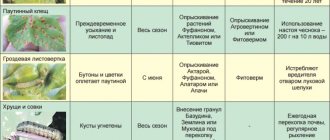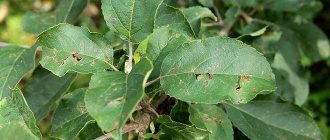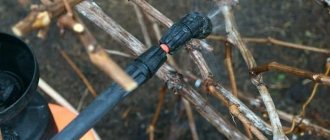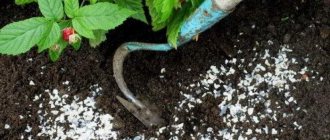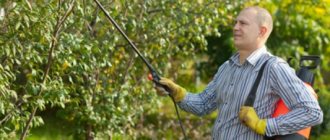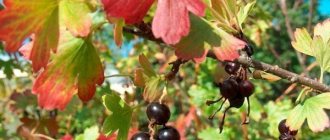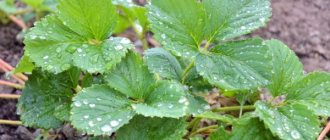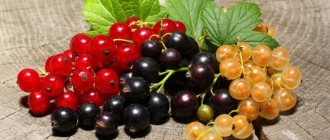Digging up the tree trunk circle, black steam
What advantages do we get when digging:
1. Pests die. As you know, many pests overwinter in the soil. And if in the fall you shovel the tree trunk circle with a turnover of the layer, then most of the larvae will die from frost.
2. Additional area for planting appears. You can grow shade-tolerant flowers or even vegetables under trees.
What do we get from the disadvantages of this method:
1. Beneficial insects die.
2. The roots are damaged. The fact is that in many trees and shrubs the bulk of the small roots that absorb water and nutrients from the soil are located at a depth of 30-40 cm. By digging up the soil with a shovel bayonet, we injure or destroy more than half of these roots!
3. The frost resistance of the tree decreases. In winter, dug up soil freezes much deeper than undisturbed soil. The cold can kill the roots and the tree will die.
4. The quality of the land is deteriorating.
If you dig up the tree trunks every year , over time the earth will turn to dust and will “float” and peck after every rain or watering. And this, in turn, will lead to oxygen starvation of the roots.
How to bury apple tree seedlings for the winter. Useful tips
In order to preserve seedlings purchased in the fall until spring, in winter for further planting, it is recommended to follow some tips:
- It is best to dig in plants with a light soil mixture; in the spring it will be easier to dig them out of the ground without damaging the roots.
- You can fill the seedlings with moisture before planting them for the winter in this way: tie the young plants together and put them in a barrel of water. To prevent the plants from floating and the roots to be completely covered with water, tie something heavy to the bunch of seedlings, such as a brick or stone.
- When digging planting material into a trench, make a place nearby where the seedling will not be located. In the spring, you can safely check how much the soil has thawed in this place without damaging the plants in the trench.
- When storing by dripping, do not cover the above-ground parts of plants with roofing material or polyethylene, this will lead to the formation of heat. Seedlings may wake up ahead of time, nutrients will begin to flow to the buds from the roots, and the plants’ immunity will decrease.
- If you dig in coniferous plants, be sure to check the soil moisture from time to time and, if it is dry, moisten it. Dry soil is very harmful to conifers.
- If the seedlings' buds have started to grow, they can still be buried. Nothing bad will happen to them. This often happens in warm autumn.
- Before spring planting, seedlings can be buried in the greenhouse. Be sure to monitor the temperature in the greenhouse, because seedlings can begin to grow even in winter, when the sun is warm.
- If the cellar is dry, this has a bad effect on storing plants. To increase the humidity in the cellar, lightly spray the floors with water.
- If a seedling is affected by mold, then there is no point in trying to preserve it until spring. By the time spring arrives, this plant will be completely infected with mold.
- In the spring, before planting in open ground, it is advised to let the seedlings get used to the light. To do this, they are transferred for a couple of days to a place where there is light shade. Then the plants will not get sunburn when planted in the ground.
Option for a grass lawn under fruit trees
What benefits do we get from this:
1. The quality of the land is constantly improving. In an untouched area, plant roots and earthworms create a special soil structure - loose, porous. As a result, both moisture and air penetrate into it better.
2. Trees receive fertilizer. The grass that dies every autumn gradually decomposes, and this provides additional organic nutrition for the tree.
3. Plants winter better. Grass under trees and shrubs provides additional protection for the roots from frost. And the internal heat of the soil does not evaporate so quickly. And this is very important in snowless winters!
4. The roots do not overheat in summer. The grass perfectly protects them from the scorching sun.
5. You won’t have to do unnecessary, and labor-intensive, work. Since digging up a site and weeding are the most unpleasant and tedious tasks. And if you leave a meadow under the trees, you won’t have to strain yourself once again.
6. There will be additional space for a recreation area : place a table and a bench on the green grass under a tree, where you can hide in the summer heat!
What are the disadvantages we have:
1. Pests and pathogens will be able to survive. They will overwinter well in undisturbed soil, and in the spring you will have to treat the plants with chemicals. But if you constantly look after the garden and do not forget about preventing diseases and pests, then this, in fact, is not a problem. In addition, beneficial insects can also survive in the soil, which will help you fight harmful ones.
2. Loss of usable area. On the other hand, no matter how much land you give to a summer resident, he will still not have enough. And the lawn under the tree can also be used for planting. For example, mark out bulbous plants there: snowdrops, pushkinia, corydalis, hellebores or daffodils.
What a conclusion suggests itself: As you can see, the option when grass grows under a tree has much more advantages. So it makes sense to abandon steam in favor of meadow.
In this case, you can create a man-made lawn in the tree trunk circle. Lawn grasses such as bentgrass, clover and other ground cover plants grow well under the trees. They can be sown from spring to September and even before winter.
Disadvantages of digging up soil in the tree trunks
It seems that everything is rosy, and we grab a shovel, but such active pressure may also have disadvantages.
The most common disadvantage is that by pushing the bayonet of a shovel in full length, we injure the root system of plants. Remember: it is better to dig up the soil in the bite zone to a depth of 10-15 cm, there is no need to go further. You can either expose the roots or damage them: bare roots can freeze in winter, and through the damage, like through an open gate, infection can easily enter. There’s nothing you can do about it, but you must admit that this is a minus not of the method itself, but of the gardener, especially an untrained beginner, who, after reading these very lines, will not do this again.
The second disadvantage is, oddly enough, but frequent digging may not improve, but worsen the quality of the soil, especially in years accompanied by frequent winds and droughts: the wind will simply remove the nutrient layer from the dug up soil. But there are many nuances here: firstly, what kind of soil is on your site: if it is black soil, then, as they say, only a hurricane can “blow away” the nutritious top layer, and then everything around will suffer, and not just this particular tree. And if the soils are light and sandy, then maybe there is no need for digging at all, that is, in principle, you can get by with banal loosening to break up the soil crust.
Severe loss of moisture is another reason why it is better not to touch the soil. This again applies to residents of dachas: if you water the soil little, but often fight weeds, loosening and digging up the soil, you yourself, unwittingly, stimulate increased evaporation of moisture from its surface and even deeper layers, which naturally leads to moisture depletion in the soil, and the plants on such an “ideal” tree trunk circle begin to dry out from lack of moisture. And again, this is not the problem of digging up the soil, but the problem of the summer resident himself: who is stopping you from installing a drip irrigation system or fertilizing the soil well with moisture after each digging. Forgive me, but if you have enough strength to dig up the soil in the tree trunk, then quite possibly you will have enough strength to water this very tree! On top of everything else, if you don’t dig up the soil, then, say, a short or medium-long rain will not be absorbed into the soil, but will flow down the soil crust, and although dug up soil has risks, it also has every chance of being enriched with moisture.
And finally, digging up the soil in the autumn, especially for newly planted plants and stone fruits, can lead to banal freezing of the root system, and this is very dangerous and can both cause the same infections and lead to the death of the plant as a whole. Although, who is stopping you from mulching the soil after this digging, the mulch will penetrate into slightly deeper layers, will be covered with snow, and when the snow melts, it will turn into the first food for the same young plants, which will be delighted with such a gift and will use it while you are walking through the impassable mud You won’t even get to the plants yet.
So, most gardeners are still in favor of digging up the soil in the near-trunk zone of fruit trees, but wisely!
Digging a trunk circle in the garden. © Alex
Caring for an apple tree in the fall - tips for properly preparing the tree for winter
Adding an article to a new collection
Autumn care for apple trees should begin immediately after harvesting. If you do everything correctly, the trees will winter well and next year will delight you with a bountiful harvest.
The main care for this fruit crop in the autumn consists of watering and fertilizing, as well as cleaning the trunks and whitewashing them. The final stage of maintenance work is insulating the trunks for the winter, as well as preventive treatment of trees against diseases and pests.
In order not to get confused in the order of actions and not to miss important points, I recommend preparing in advance all the necessary materials and equipment and drawing up a detailed work plan, which should include the following points.
Rules for caring for young trees
Gardeners have special requirements for caring for a young apple tree in the fall; it consists of several points:
- unlike old plants, they are not frost-resistant, so be sure to cover them with non-woven material;
- water apple trees in autumn in small quantities - no more than 1 bucket under the trunk of 1 tree;
- if the plant is more than a year old in the fall, prune it in the fall from diseased and dried branches so that nothing interferes with the formation of new beautiful shoots.
You can trim the crown of a tree to create a beautiful appearance; the most popular methods include shortened, sanitary and contour pruning. It is better to do it with the help of special garden shears. Be sure to remove shoots only at a sharp angle.
Watering apple trees in autumn
Watering is especially important if autumn is dry. Sometimes even heavy rains that occur after a long period of drought moisten the soil by only a few centimeters, and this is not enough for apple trees. In order to provide trees with a sound and safe winter sleep, the soil should be moistened both directly at the trunk and along the boundaries of the crown. Get ready for a lot of water consumption, because you need to spill the soil to a depth of at least one meter.
Determining how much water is needed to water apple trees is not difficult. It depends on the age of the tree. The older it is, the more developed its root system and crown are, so the amount of irrigation water should increase over the years. Thus, apple trees aged from 1 to 5 years require about 50 liters of water for each tree, 6-10 year old trees - approximately 100 liters of water, trees over 15 years old - about 150 liters of water.
Ideally, the root system of the apple tree should be completely saturated with liquid, as should the soil around the roots. This will give the plant strength, and the moist soil will not freeze to a great depth.
When to dig up the trunk circle of trees?
Most fruit growers are for keeping the tree trunk clean and for digging it up, that is, for black steam under an apple or pear tree, cherry or plum, and so on. At the same time, a one-time digging of the soil will not solve much; it is better to do it four or even five times during the season.
Usually, tree trunk circles are dug up for the first time in early spring, when the snow melts and the soil warms up. Digging at this time allows the soil to quickly warm up to a greater depth, and then it is enough to wait a week, let it warm up thoroughly, and you can safely mulch it with a layer of compost a couple of centimeters deep, giving the plants additional nutrition. In addition, compost, which has become forgotten, will inhibit the growth of weeds, reduce moisture evaporation, and reduce further overheating of the soil. You can also combine digging up the soil with composting and adding fertilizers, for example, nitroammophoska in liquid form (a tablespoon per bucket of water and a couple of liters per tree).
At the same time, try to dig up the soil not right next to the trunk (with stone fruits it is generally dangerous to do this, there is a sensitive root collar: moisture will collect and the neck will begin to rot), because here, basically, there are thick roots that hold the plant, and a little further away, on 12-15 cm from the trunk (absorbing roots, the most active ones, are often located in this zone). The benefit from such (correct) digging will be maximum.
Important! When digging the soil around a tree, place the shovel on its edge (along the direction of root growth, and not across their growth path), this is the only way to minimize the risk of injury to the tree’s root system.
Carry out the second digging of the soil in mid-summer, combine it with the application of potassium sulfate (15-20 g per square meter, also better in liquid form), removing weeds and, if necessary, watering (a couple of buckets under the tree). Then you can mulch with 0.5 kg of compost for each tree (after digging).
Important! When adding raw compost to stone fruit plants, try to move 2-3 centimeters away from the root collar to avoid damping off; under no circumstances should you pile fertilizers, including other types of mulch, on it.
The need for a third digging is usually determined as the tree trunk becomes clogged with weeds and the soil is compacted; weeds are also removed and fertilizers are applied, but this time wood ash (a source of potassium and microelements, like soot) or soot 250-300 g for each plant . You can also mulch the plants with compost, a kilogram for each.
The fourth digging of the soil can be carried out in September; it can be combined with moisture-recharging irrigation by pouring 5-6 buckets of water under each plant for three or four days. At the end (after digging), so that the moisture does not evaporate, you can also mulch the surface with compost a centimeter and a half thick. Mulching with compost can help protect roots that are accidentally damaged by digging the soil.
The final digging of the soil, which is already our fifth, can be carried out just 5-7 days before the onset of a period with stable negative temperatures. Here you need to rid the tree trunk circle of all plant debris, dig it up and mulch it with humus, in a layer of 4-5 cm, to protect the roots from freezing.
After a busy summer season, I want to relax as soon as possible and, if possible, reduce the list of work. One of them - digging up the earth in the fall - was until recently carried out by all gardeners and was considered very important.
And now the question increasingly arises: is this really a necessary procedure, is it worth spending time and effort on it, or can you get by with just spring digging? So, let's finally find out whether it is necessary to dig up the garden in the fall and understand all the intricacies of this work.
Preparing beds in the fall for the new season is one of the most important conditions for obtaining a rich harvest. Over the winter, the soil is saturated with minerals that were added during digging. Snow saturates the beds with moisture faster, while the dug-up soil itself does not become compacted. As a result, in the spring it is much easier to carry out preparatory work before planting. Significantly save energy and time. But that’s not all the advantages of digging!
Feeding apple trees in the fall - choosing the right fertilizers
After watering, or possibly simultaneously with it, you should also fertilize the apple trees. For this, potassium and phosphorus fertilizers are most often used.
Fertilizers applied along with irrigation water penetrate much faster to the depth required for the root system and are more actively absorbed by plants than those simply scattered on the surface of the soil.
Feeding is an equally important component in apple tree care.
As a means of soil enrichment, you can use both ready-made fertilizers, which are sold in garden supply stores, and those prepared independently. If you decide to prepare the fertilizer yourself, first buy dry ingredients: potash and phosphate fertilizers. To prepare a solution in 10 liters of water, you need to add 1 tbsp. any potash fertilizer and 2 tbsp. any phosphorus, for example, superphosphate. The solution should be mixed well. This amount should be enough for 1 sq.m of tree trunk circle - for trees under 10 years old or 0.5 sq.m - for trees older than 10 years.
Nitrogen fertilizers cannot be applied in the fall, because they stimulate the growth of shoots that will definitely not ripen and will certainly freeze in winter.
When and how is mulching done?
The right time to carry out the procedure is spring, when the soil has warmed up sufficiently and its top layer has dried out a little.
Recommended mulch layer thickness (in mm):
- straw, hay, grass – 100-150;
- nettle – 50;
- shavings, wood chips, sawdust – 70;
- bark from 50;
- conifer needles 30-50.
In climates with cold winters, autumn mulching of tree trunks is important. This measure will help protect the roots from freezing and saturate the soil with beneficial bacteria.
The protective layer should be placed around the trunk, retreating from it by 10-12 cm, so that unnecessary daughter roots do not begin to form in the moist substrate. The size of the circle should be approximately equal to the diameter of the crown, if the tree is large - at least 1.5 m.
Stripping apple tree bark
Do not neglect thorough stripping of the bark
Before you start cleaning the trunks of apple trees, be sure to remove the trapping belts from them, take them outside the garden and burn them. Then spread a film or an old blanket under the trees and, armed with a wooden or plastic scraper, remove all the old, loose bark, moss and lichens. This way you will destroy the pests that hibernate there.
When cleaning the trunk, use tools carefully, trying not to damage the living tissue of the tree. This is especially dangerous if there has been no rain for a long time and the surface of the tree has dried out. Taking this into account, it is advisable to clean the trunk immediately after rain or after watering the tree trunk with water. Wet bark comes off much easier.
If during the cleaning process it was not possible to avoid damage to the bark, immediately cover all the wounds with brilliant green or spill them with a solution of hydrogen peroxide, and then cover them with garden varnish. Try to do this as quickly as possible, otherwise the wound may become infected.
Pre-winter watering
Well-moistened soil helps plants survive the winter easier and increases their resistance to frost.
Also, moist soil better conducts heat from the lower layers of the earth to the roots of plants. But it should be remembered that excessively moist soil can, on the contrary, displace all the warm air. In this case, the roots of the plants begin to suffocate, which leads to their death. Therefore, you need to look at the condition of the soil: if it rained in the fall and the soil was sufficiently moist, then you should not water. But if there was no rain at all during August-September, the ground has dried out, it is necessary to carry out. In this case, you need to pour at least 40 liters of water (4 buckets) under each adult bush.
Treatment of apple trees against diseases and pests
Preventative pest control measures will help avoid problems in the future.
In a small private garden there is no point in using strong chemicals. All treatments should be carried out on a dry day, when there is no frost. The first step is to protect apple trees from scab. A urea solution will help with this (450-500 g of urea per bucket of water). Spraying with 3% Bordeaux mixture gives very good results in the fight against fungal diseases of apple trees. The mixture can be purchased at the store, but I usually make it myself. I take 300 g of copper sulfate and 400 g of slaked lime and dissolve it all in 20 liters of water, and then treat my apple trees with the resulting solution.
Apple tree rescue
If there were apple trees, there would be apples. But the apple tree is a delicate tree, susceptible to various diseases and pests. In this review, we will tell you what to do to ensure that the main tree of the orchard remains healthy: we will analyze some of the apple tree problems that users of our portal had to face.
The parents of FORUMHOUSE user Znata bought a plot of land planted with apple trees. They were terribly happy that now they would have their own apple orchard, but it turned out that the trees were sick: almost all the trunks were covered with multi-colored spots of mold, and there were dry and rusty spots on the leaves. If you saw off a branch, it turns out that it’s all brown inside.
How to help such a garden? How to cure it? Cutting down all the apple trees and planting new ones - I just can’t raise my hand, it’s such a shame. But it seems that there is simply no other way out.
As we can see, the apple trees are very neglected: there are lichens and scab on the trunks, pests feast on the branches, all the bark is sunburned and frostbitten.
Dark brown wood on the cut branches indicates that the tree was damaged by frost at one time. Healthy, light wood has grown onto the frozen wood, but the strength and flexibility of such branches is very weak - they can break off even with a slight load. Restoring such trees requires experience and knowledge, but the situation is not hopeless. The process of saving apple trees will be long and troublesome, and no one guarantees success, but most of the branches have been preserved, which means the trees can recover.
FORUMHOUSE consultants toliam1 and Lobelia advise not to panic, but to do this:
1) In order for the tree to feel better, it is advisable to prune it: lower it and thin it out. You can trim all dry branches immediately, and in the spring you can also trim off excess living branches, for example, the lowest ones or those that run too far to the side. But you need to trim a little, literally 2-4 living branches on each tree. The fact is that an apple tree is usually pruned from a very early age, and if the tree has not been pruned for 30 years, it may simply not tolerate radical pruning. Therefore, you need to start little by little. The first candidates for pruning are branches with peeling bark, looking inward, that extend from the trunk at a very sharp angle, less than 30 degrees.
If an apple tree has not been pruned for 30 years, it may simply not tolerate radical pruning.
2) Gray spots of mold are lichens. Lichen is not harmful to apple trees; a solution of iron sulfate (400 grams per 10 liters) can deal with it. If the tree is slightly stripped, go over the trunk with a brush dipped in the solution. If the situation is more serious, spray the damaged areas.
But the pink spots are most likely mushrooms. Branches affected by fungi will have to be removed.
LobeliaForumHouse Consultant
I would not recommend cleaning the trunk with sandpaper; the tree is old and every wound surface is dangerous. It’s better to walk over the lichen with a solution of iron sulfate. After this treatment, the lichen will disappear on its own, plus there will be disinfection.
3) In the fight against aphids, you need to use as few chemicals as possible: the aphids get used to them. But what she is afraid of is celandine. Aphids try to avoid trees under which celandine grows. If you tie a sprig of celandine to the center of aphid accumulation, it will die within a day.
4) To regulate acidity, in the spring these apple trees need to be dug up well, excess water drained and fed with nitrogen. Apple trees are generally sensitive to soil acidity. You can control acidity with red beets. Plant the beets in a circle around the trunk: if the leaves are green and the petiole is red, then everything is fine. If the leaves, veins, and petiole are red, then deoxidation is required.
toliam1FORUMHOUSE Consultant
Apple and plum trees do not do well in acidic soil. A neutral or slightly acidic reaction of the soil solution is desirable. It is necessary to add dolomite flour to the tree trunk circle in a dose of 300-500 g/m square (a glass and a half), which can be sprinkled before winter. The melting snow will drag her to the depths.
5) The spots on the leaves look like scab. Scab is considered the most common apple disease. This is a fungal disease that occurs due to high humidity and stagnation of air inside the crown. The scab moves from the leaves to the fruits.
On the leaves, scab looks like this - numerous spots appear on the inside, similar to the touch of kiwi skin. To combat scab in spring and autumn, the crown of the apple tree is sprayed with a urea solution (0.5 kg of urea per 10 liters of water). One average tree requires about 5 liters of solution. In the spring, they are treated with copper oxychloride (40 grams per 10 liters of water.) The treatment is carried out in two stages: before flowering and after fruit set.
The best way to protect against scab is to regularly prune your apple tree in spring.
The apple trees of FORUMHOUSE user alisa suffer from black cancer. This is a common disease - recently even very young apple trees that have not yet bear fruit are affected by it. Alice fights it this way: she scrapes off the bark and wood until it is healthy, disinfects it with iron or copper sulfate, covers it with garden pitch or a mixture of fresh mullein and clay, and bandages it with matting or film.
Mushrooms began to form on the apple trees of user FORUMHOUSE uri39. It is very dangerous! The fact is that mushrooms loosen wood and can turn it into dust. Therefore, the first thing to do is to clean the bark, if necessary, using a semicircular chisel. Just very, very carefully!
What we have next is this:
- Remove the peeled bark and wood outside the site and burn it.
- Treat the cleaned area on the tree with a 4% solution of iron or 2% copper sulfate (that is, 40 grams per liter or, respectively, 20 grams per liter).
- In the fall, the tree must be whitened with a solution: 10 liters of water, 2-3 kilograms of lime, 1 kilogram of clay (if we are talking about old trees) and 400 grams of copper sulfate dissolved in hot water. There is no need to add copper sulfate to the solution intended for whitewashing young trees.
JulliFORUMHOUSE user
All dry branches must be cut out and burned outside the site. And sprinkle the ash with soil so that there is no breeding ground for diseases.
Black spots with white fungus-like growths appeared on the Vassili apple tree. The growths formed mainly on cracks, wounds and pruning areas. I didn’t want to cut off the strong, fruit-bearing branches, but Vassili was afraid that the tree had black cancer.
Based on the descriptions and photographs, FORUMHOUSE experts determined that it was not cancer, it was a sooty fungus. It starts on both plums and pears. If you have this infection, treat the garden with a solution of iron sulfate (for an apple tree - 400 grams per 10 liters of water, for pears and plums - 300 grams). Spray either in late autumn or early spring, before the buds open. When carrying out processing, do not forget about the bushes - especially black currants, since it is the old black currant bushes that spread the sooty fungus.
If the lesion has gone deep into the bark, it must be stripped back to healthy wood without delay until autumn, disinfected and covered with garden varnish.
Usually, sooty fungus appears on weakened trees, so the best prevention is proper care of the apple tree: watering, fertilizing, pest control. In autumn, at the end of leaf fall, the apple tree should be fed with phosphorus-potassium fertilizers: they increase frost resistance and have a beneficial effect on yield. Cracks and wounds must be covered with varnish in a timely manner. There is another technique that helps fight cracks, which few people know about - furrowing.
Furrowing is not the most common procedure among gardeners, however, it prevents the formation of cracks in the bark and helps thicken the trunk and skeletal branches.
FORUMHOUSE user heladas has been practicing furrowing for a long time, and is pleased with the result. On the bark of the apple tree, he makes longitudinal cuts 1.5-2 mm deep in 10-centimeter sections. The incisions are disinfected with a 5% solution of copper sulfate. The first furrowing is done 3-4 years after planting the apple tree on the northern side of the trunk, and after another 3-4 years - on the western and eastern sides. The point of the procedure is that a new, elastic cortex is formed along the line of the furrows.
Cracking of an apple tree trunk happens much more often than its owners would like. It’s especially offensive when the trunk of an apple tree covered with filling fruits literally breaks into two parts. I really don’t want the apple tree to die - how to save it? How to merge these two halves?
FORUMHOUSE experts warn: do not waste time! You can save the apple tree, you just need “a couple of men and some tools.” You need to drill a hole through both halves, insert a long bolt into them and tighten the parts into one whole. Disinfect wounds and lubricate with broth. The bolt will eventually grow into the wood, and the apple tree will thank you.
How to save an apple tree whose trunk has been chewed all over by mice? Watch the video: a famous breeder scientist tells and shows how to make a bridge graft. FORUMHOUSE discusses how to care for an old orchard and correctly do rejuvenating pruning. We also suggest you read the article about different varieties of apple trees.
Autumn whitewashing of apple trees
The optimal time for whitewashing an apple tree in the fall is early to mid-November, when the autumn rains stop. The composition for whitewashing trees can be purchased at the store or made yourself. If you decide to cook it yourself, take 2.6 kg of lime, 600 g of copper sulfate and 250 g of casein or wood glue. Dissolve all this in 10 liters of warm water, let the mixture stand for a while and you can start whitewashing the apple trees. It is best to choose a dry, fine day for this. In wet weather and during rain, it is better not to whiten trees.
Insulating tree trunks for the winter
And the last stage is protecting trees from winter cold and rodents. Wrapping the trunks in burlap or other similar breathable fabric will help with this. To secure the material, it must be tied to the trunk with twine or glued with tape. You need to wrap the trunk of the apple tree so that the lower part of the fabric remains on the ground (if the trunk has not been whitewashed), later it can be cut on the sides and sprinkled with earth. This is necessary to ensure that pests do not penetrate under the strapping material.
Also an important point in the autumn care of apple trees is sanitary pruning of trees. If you do everything correctly, your trees will calmly overwinter and next year will produce a good harvest of delicious, juicy apples.
How to properly dig up the soil in the fall in the garden
Depending on the crop that will be planted next year, select the appropriate depth for digging the soil:
- 25-30 cm (per spade blade) – for potatoes, beets, carrots, pumpkins, melons and parsley;
- 5-10 cm – for tomatoes, cucumbers, peppers, radishes and legumes.
It is advisable not to turn the soil layers over, but to transfer them among themselves in order to preserve as much beneficial microflora as possible. It is better to remove the roots of weeds rather than bury them. It is much easier to carry out such digging. But if the soil is very hard and rocky, you will have to do two-tier digging with two shovels. And here it is no longer possible to do without turning over the layers of soil. But resorting to such digging should only be done as a last resort.
A shovel, fork or cultivator are suitable tools for digging.
Shovel. Used on small plots of up to 10 acres. A budget option that will cope well with different types of soil, but is quite labor-intensive.
Pitchfork. They allow you to achieve a finer soil structure, which young plants like, but is not always achieved with a shovel. It also requires effort.
Cultivator. The soil quickly becomes loose, plant roots feel great in it. It will save time and effort when working on a large area, but it will not cope with very heavy soils, and it is not cheap.
If the garden requires digging, but there is no way to do it, sow green manure. They will loosen the soil to a depth of 2 m, saturate it with useful elements and reduce the activity of pathogenic microflora. And in winter they will hold snow well and prevent the beds from freezing.
Whether to dig a garden in the fall is up to each summer resident to decide for himself. If you have heavy clay soil on your site, then it is better to dig, but if it is loose and light, you can only get by with a spring procedure, replacing autumn digging with deep loosening. To reduce the load on soil microflora, dig once every few years as necessary.
Garden care in autumn - protection, fertilizing, watering
In autumn, it's time to take care of the condition of your plot and garden. Creating comfortable overwintering conditions for fruit trees is the primary task of gardeners. What does garden care include in the fall? On the eve of the winter cold, after the leaves have completely fallen off, you can begin sanitary pruning, thinning, and reducing the crowns of perennial trees to 4-4.5 m. It is better to postpone detailed anti-aging pruning until spring. Why? Firstly, there are concerns about the possibility of trees freezing. Secondly, places where perennial branches of large diameter have been cut can become a source of frost damage even when treated with garden varnish or oil paint.
In the fall, a thorough inspection of fruit trees is carried out, dry, damaged branches are removed. Along with the removal of diseased, dry branches, trees are cleaned of fruits that have dried on the branches, nests and egg-laying pests are burned, growth is cut out, leaf litter and root shoots are removed, where many types of aphids have accumulated.
Mulching
In regions where rain is rare and frosts are not, summer residents use dry manure, straw, peat or leaves with reeds in the form of mulch. There are reasons for this:
- this is a natural fertilizer that is dug up in the spring and gives the roots additional nutrition;
- such mulch warms the soil;
- retains moisture well.
It is important to know: such mulching should be done not only 10-15 cm from the trunk, as many gardeners do, but throughout the entire circle around the trunk.
However, in warmer regions, an increasing number of summer residents prefer not only to mulch the circle of fruit trees, but also to decorate it. Pine cones, for example, are great for this. They look beautiful, hold heat well, transmit and retain moisture, are not blown away by the wind and do not give weeds a chance to grow through such a barrier.
In any case, the choice of which natural material to use for mulching remains with the summer resident, based on weather conditions and the needs of the tree itself.
Protecting fruit trees from rodents
All this must be destroyed immediately. When cuts with a diameter of more than 2 cm are formed, they are covered with garden pitch. The trunks of young trees are tied along the entire length with a special non-woven material or other available means to protect against damage by mouse-like rodents with the tying material being buried 3-5 cm into the soil.
For example, I do this. I wrap young trees with narrow bandages cut from spunbond or lutrasil. And then I start digging - the ends of the bandage are buried in the earth, as if buried.
The feasibility of mulching the soil
All gardeners struggle with weeds. But by exposing the soil, they expose it to other dangers: erosion, drying out, weathering, freezing. Therefore, the soil must be covered. Covering material for mulching trees and shrubs should perform the following functions:
- protect the soil from erosion;
- retain moisture, reduce the frequency of watering;
- protect the tree’s root system from being washed out by rain;
- maintain optimal soil temperature;
- prevent the spread of weeds;
- help increase the amount of nutrients in the soil;
- improve the appearance of the site.
There are many different materials that are capable of performing these tasks to one degree or another.
Processing of trees, shrubs, grapes
On stone fruits, against diseases in the fall, you can treat them with copper preparations, for example, Bordeaux mixture, and on pome trees, with Preparation 30. Treatment with Preparation 30 can be postponed until the spring. Pass it over the swelling buds.
In the vineyard, the plants are also carefully inspected after harvest. Before sheltering for the winter, be sure to take care of keeping the plants in a healthy condition. If the presence of the leaf form of phylloxera has been noticed, it is necessary to treat the swelling buds with Preparation 30 in early spring. Unripe shoots must be cut out in the fall. If shoots affected by anthracnose are noticed, in the fall or early spring the bushes are treated with 3% Bordeaux mixture - this is one of the universal fungicides that has the longest protective effect.
The importance of autumn care
Measures carried out in the correct order for the autumn care of fruit trees after the end of the harvest help to increase their winter hardiness, that is, the ability not to suffer from any weather disasters - severe frosts, sudden thaws, and most importantly - the alternation of both.
Strengthen the immunity of plants, reduce the volume of branches, protect against pests and diseases, and add nutrients in the fall so that trees and shrubs, waking up in the spring, can immediately use them - all this work needs to be done in a fairly short time.
Skipping any of the stages risks not just catching up in the spring, but a lack of harvest or even the death of the entire plant.
Feeding fruit trees
In late autumn, organic, organomineral or mineral phosphorus-potassium fertilizers are applied - superphosphate, potassium sulfate, etc., 6-9 g of active substance per 1 m 2. Fertilizers are applied into holes or wells 20-30 cm deep into the area of tree trunks at a distance of 0.5-1 m outside the crown projection or under digging. One or two holes or boreholes are made on each square meter.
For orchards, long-acting fertilizers are most important. The main ones are organic and organomineral fertilizers. Nutrients from them are released slowly as they are decomposed by microorganisms. The composition of organic fertilizers (manure, composts, etc.) includes the entire set of nutrients necessary for perennial fruit and berry plants, as well as hormones, vitamins, etc. Their application affects the growth and productivity of trees for 3-5 years, while the productivity increases to 25 and even 50 percent.
Organo-mineral fertilizers include both organic (peat, humates, etc.) and mineral fertilizers.
According to the Institute of Horticulture and Viticulture, in the fourth year after applying mixed fertilizers (organic and mineral) under a fruit-bearing apple tree (to a depth of 15-18 cm), the content of nitrogen, phosphorus, and potassium available to the plant in the soil at a depth of up to 60 cm is several times higher keeping them in non-fertilized areas of the garden. This is due to the fact that fertilizers applied locally during the autumn digging of the garden by 2/3 of a shovel are localized in the application zone, creating nutritional centers within the boundaries of the main distribution of the root system of perennial plants.
In addition, in areas of the garden or vegetable garden where organo-mineral fertilizers were used when digging the soil, you can also notice that the soil has become looser and crumbles well. This means improving its agrophysical properties.
When using fertilizers in the fall, it must be remembered that the application of fast-acting species can lead to the activation of growth processes in trees against the backdrop of warm weather and a sufficient amount of moisture in the soil, which will cause serious damage in winter due to low negative air temperatures.
For autumn refilling of the garden soil in late autumn (November), as a rule, phosphorus-potassium fertilizers (nitrophoska, nitroammofoska) are used, and in earlier periods (October) ammonium forms of nitrogen fertilizers (ammonium sulfate, ammonium nitrate) can be applied. In this case, the dose of nitrogen fertilizers is divided: in the fall, 1/3-1/2 doses are applied; in early spring, 2-3 weeks before the trees flower, apply intra-soil fertilizing with fast-acting nitrogen fertilizers (1/2-1/3 of the main dose); in the summer, the remaining dose of nitrogen is added with irrigation water.
Autumn filling of the soil with fertilizers contributes to the formation of resistance of fruit plants to unfavorable environmental conditions, since the winter hardiness of trees is determined to a large extent by how many nutrients they accumulate in preparation for winter and to what extent these substances turn into protective substances. A prerequisite for sufficient accumulation of reserve nutrients is the optimization of the nutritional regime of fruit plants, which allows for dynamic growth of all organs, withstanding spring temperature changes, blooming profusely in winter and forming a full-fledged harvest.
Features of mulching various garden crops
The covering process varies depending on the type of planting.
Mulching apple and pear trees
The tree trunks of apple and pear trees are mulched with the same materials as other fruit trees.
Cherry mulching
Ungrafted cherries over time create a lot of growth, which is difficult to control. One of the measures may be mulching with straw or other organic matter. The heat causes the soil to crack, and new shoots immediately form in the cracks. You can reduce the number of unwanted shoots by mulching the ground around the tree with inorganic materials.
Mulching shrubs
Shrubs need shelter no less than trees. Among the varieties of mulch, you can use sawdust, bark, or better yet, compost or humus.
How are coniferous plantings mulched?
Conifer plantings are mulched in spring and autumn to retain moisture in the soil. Recommended material is tree bark. If you use stones, it makes sense to put agrofibre under them.
Covering the tree trunk area means caring for the plants, which will reward it with high yields. Protection from pests and adverse weather conditions will serve as an additional argument in favor of mulching.


